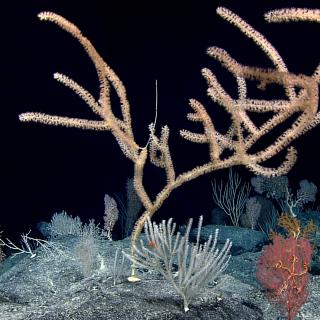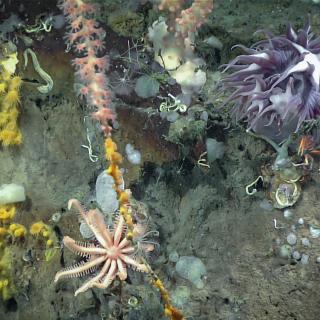What’s in a scientific species name? Examples from deep-sea fishes of Lebuu's Voyage in Palau
by Ken Sulak, US Geological Survey (retired) and OET Scientist Ashore Network participant
In the late 1700s, Swedish Biologist Carl Linnaeus invented the binomial system (two names) of naming organisms. Under this naming system, each species is given both a genus name (group of closely related species) plus a species name (name identifying one unique species), originally drawing upon the classical languages of Latin and Greek. We have gotten a little more inventive now, basing species names on other languages, ships, institutions, or notable scientists.
Before Linnaeus, individual species were often identified by a long cumbersome series of descriptive words. For example, the Colonial American botanist William Bartram, despite having recently adopted Linnean binomial names, often lapsed back into the old system. In his 1774 drawing of the Celestial Lily (Ixea caelestina under the binomial system), he also tacked on its older full Latin descriptor name: “Rad bulbosa subrotunda, Candis teres vaginatus, Foliis linearis lanceolatis, cuspidatis Floribus expansis Magnis caeruleis.”
Thankfully, the simple two-name system caught on. When a newly discovered species is described, increasingly with input from the local community of the observation, its scientific name is formally published, adopted as official, and used worldwide. Naming conventions and rules are formally prescribed in the International Code of Zoological Nomenclature. In public conversation, common species names are also used, but these vary regionally, nationally, and linguistically. This can lead to confusion so in general science dialog, the binomial species names are preferred. The American Fisheries Society and the informational website ‘Fishbase’ both work to standardize common name usage for fishes.
So, what do some of those strange-sounding deep-sea fish names mean? This album some examples of deep-sea fishes encountered during the Lebuu’s Voyage expeditions within the Palau National Marine Sanctuary (NA167 and NA168), including their italicized scientific names based on their mostly Latin and Greek word roots, along with their common names.
Additional fishes not pictured:
Diplacanthopoma brachysoma [two-spines on gill cover + short body]. This name is kind of a misnomer, since this fish is really a rather elongated cusk eel. This fish has no common name. This overall group of fishes is known as cusk eels, and unfortunately also as assfishes, which is also a misnomer. Cusk eels bear no resemblance to either a mule or to the anatomical body region.
Spectrunculus grandis [ghost-like + large]. Pudgy Cusk Eel.
Acanthonus armatus [Spine-bearing + armored]. Bony-Eared Assfish. Not a good or appropriate common name. A better common name would be spiny-cheek cusk eel. The name bony ear does not refer to the two long spines protruding from each gill cover, but to the enormous ear stones in the inner ear of this abyssal cusk eel.
Halosauropsis macrochir [ Saltwater-lizard resembling + large jaw]. No common name, but I use Midnight Halosaur for this jet-black fish.
Synaphobranchus brevidorsalis [gill openings co-joined + short dorsal fin]. Short-finned Cutthroat Eel
Kumba sp. [Kumba is an anagram in honor of the United Kingdom Marine Biological Association (UKMBA), whose research vessel Sarsia collected the type specimen of the genus]

Lebuu's Voyage I - Palau
Palau National Marine Sanctuary (PNMS) –protection secured by Euotelel a Klingil a Debel Belau– is one of the most ambitious conservation efforts on Earth. Despite being rich in natural and cultural resources, there is very little data available from deep ocean habitats protected within PNMS. Working closely with the Palau International Coral Reef Center (PICRC), NOAA Ocean Exploration, and other Palauan and U.S.

Lebuu's Voyage II - Palau
Building on the progress in the first expedition, this 11-day expedition will continue exploring Palau National Marine Sanctuary (PNMS) to understand seafloor features and the biodiversity that call deep sea habitats around Palau home. Specific cruise objectives will continue to be refined as we work with community and scientific partners.
![Bathypterois atricolor [deep-winged + dark color]. Attenuated Spiderfish.](/sites/default/files/styles/photoswipe_thumb/public/images/2024-11/image1.jpg?itok=ZpSEGh6q)
![Cataetyx laticeps [down-sticking – that is, staying on the seafloor + wide-headed]. A live-bearing cusk eel with no common name. Flathead Cusk Eel would be an appropriate name.](/sites/default/files/styles/photoswipe_thumb/public/images/2024-11/image2.jpg?itok=0vdX2AJW)
![Chaunacops coloratus [gaping mouth + colorful]. Rosy Gaper, Rosy Sea Toad, Colorful Coffinfish, Rosy Frogmouth.](/sites/default/files/styles/photoswipe_thumb/public/images/2024-11/image3.jpg?itok=BMwP873S)
![Ipnops agassizi [Sleepy-looking + Agassiz]. Grideye Fish, Flateye. Patronymic species name which honors the 19th Century fish biologist Alexander Agassiz.](/sites/default/files/styles/photoswipe_thumb/public/images/2024-11/image4.png?itok=SIBvN6ES)
![Synaphobranchus affinis [gill openings co-joined + related to]. Short-finned Cutthroat Eel.](/sites/default/files/styles/photoswipe_thumb/public/images/2024-11/image5.png?itok=OFJxdZiE)
![Coelorinchus sp. [hollow-snout + sp]. The common name Grenadier for the family Macrouridae derives its name from the long pointy-tipped conical head found in certain species of the genera Coelorinchus, Coryphaenoides, and Nezumia, which resemble the traditional and iconic tall pointy hats of British grenadier soldiers.](/sites/default/files/styles/photoswipe_thumb/public/images/2024-11/image6.jpg?itok=TwDnjcML)
![Aldrovandia phalacra [patronym honoring the Italian naturalist Ulissi Aldrovandi + bald-headed]. Hawaiian Halosaur.](/sites/default/files/styles/photoswipe_thumb/public/images/2024-11/image7.jpg?itok=6rO_NqVE)
![Conocara ?nigrum [cone-shaped face + black]. A bathyal slickhead or smoothhead (no scales on the smooth head). The family name Alepocephalidae means without scales on the head.](/sites/default/files/styles/photoswipe_thumb/public/images/2024-11/image8.jpg?itok=K2hDbU_0)
![Bathysaurus mollis [Deep-living lizard + soft]. Abyssal Lizardfish with a soft translucent body.](/sites/default/files/styles/photoswipe_thumb/public/images/2024-11/image9.jpg?itok=M8AHDlyl)
![Coryphaenoides longicirrhus [dolphin fish like + long barbel]. No common name for this rattail fish.](/sites/default/files/styles/photoswipe_thumb/public/images/2024-11/image11.jpg?itok=qyXLTAAS)
![Bassozetus ?compressus [Fat Monster + compressed body]. Abyssal Cusk Eel or Abyssal Assfish.](/sites/default/files/styles/photoswipe_thumb/public/images/2024-11/image12.jpg?itok=SOmflIBM)
![Bathygadus sp. [deep cod-like fish + sp]. No common name for this rattail fish.](/sites/default/files/styles/photoswipe_thumb/public/images/2024-11/image13.jpg?itok=npmzhoI-)
![Porogadus sp. [pore-bearing codlike fish + sp.]. No common name for this pointy-nosed cusk eel.](/sites/default/files/styles/photoswipe_thumb/public/images/2024-11/image14.jpg?itok=FwoPefL7)



